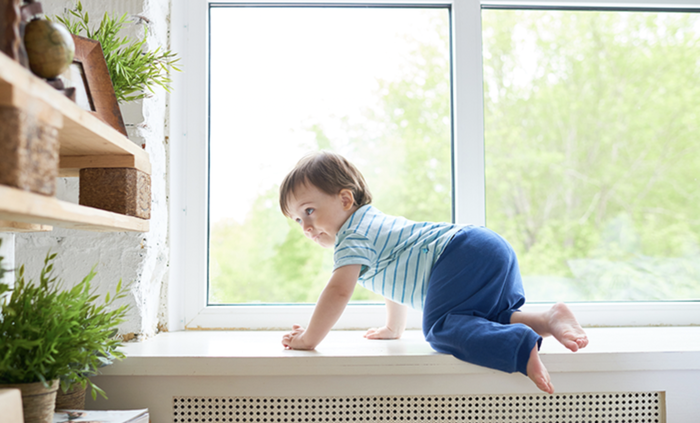Interior is an essential aspect to achieve a beautiful home. For houses with children, redesigning becomes even more necessary. In addition to aesthetics and functionality, ensuring safety is the top priority. This is also one of the topics that architects pay close attention to. Indeed, recently, regrettable accidents continue to occur due to children’s inadvertence. To make your home not only a place to live but also a safe and joyful playground, creating unforgettable childhood memories for your children, you should take to heart the 07 tips that BORNRICH shares below!
1. Safe Balconies and Windows
Heartbreaking incidents recently have raised awareness among many parents about the importance of secure balconies and windows. For buildings with children under 5 years old, the railing should be constructed to prevent easy climbing and have no openings that allow a 100mm diameter ball to pass through. To be extra cautious, families can use safety nets. As for windows, homeowners should choose windows with slim vertical bars or install safety mesh designs.
2. Fixed Cabinets and Shelves
Children are very active and often like to climb on cabinets and shelves. Therefore, freestanding cabinets and shelves can be quite dangerous and pose unfortunate risks. BORNRICH advises customers with young children to use built-in cabinets or ceiling-to-floor fit-out cabinets. These types of cabinets are usually integrated into the house interior, providing both aesthetic appeal and safety for young children.
3. Choosing Non-Slip Flooring Materials
During the house design process, you will come across various flooring material options. Some common materials include marble, engineered stone, ceramic tiles, and wood. Among them, wood flooring offers high traction, providing a cool surface in summer and warmth in winter. It is also a preferred material in homes with young children and elderly individuals. Children tend to explore and run around on the floor frequently. Therefore, using wood flooring is a suitable and recommended choice.
4. Furniture with Rounded Edges, No Sharp Corners
Using furniture with rounded edges will reduce the risk of injury if children trip or hit them. When selecting furniture, try to choose designs with rounded corners to provide better protection for children, preventing serious injuries. Limit the use of furniture with sharp corners. In case they are present, use rubber corner protectors to ensure safety for children.
5. Designing a Safe Play Area for Children
Having a separate room designated as a play area for children is a popular trend. A dedicated playroom not only stimulates children’s creativity but also ensures maximum safety. Moreover, parents can let go of the fear of cleaning up toys scattered throughout the house since toys will be confined to this designated room.
6. Design Staircases with Handrails and No Gaps:
Currently, many people choose staircase designs without handrails due to their aesthetic appeal, neatness, and space-saving features. However, for families with young children, this design can pose many dangers. Staircases are new to children, and if not supervised, they may climb up or down in the blink of an eye. Homeowners should prioritize using staircases with safe handrails and reduce the gaps between the railings. The handrail height should be at least 900mm, firm, and easy to grasp. The railings must also be secure at the edges of the steps. For staircases with open risers, the gaps between the steps must be safe, preventing children from slipping through, and the step surface should be slip-resistant.
7. Designing a Private Bedroom for Children
Having a separate bedroom allows children to develop independence and maturity. The bedroom is a space that parents should pay close attention. From the arrangement of furniture to the design and size of interior items, all of which should be carefully planned. The layout and pathways within the room should be clear and unobstructed. Additionally, ensure that the room has enough space for your child to play. Avoid cluttering the room with unnecessary items, as they may even lead to injuries. Natural light, plants, and bright colors help create a positive and vibrant space for children to play, engage in activities, enhance their learning and creativity.
THE BOTTOM LINE
The above are the things to consider when designing a home to ensure safety for young children. These design solutions not only protect children during playtime but also stimulate their creativity. With a team of skilled and experienced architects who have designed thousands of homes with young children, BORNRICH knows how to create the most suitable family interior spaces. If you have any questions or need advice, do not hesitate to contact us.

